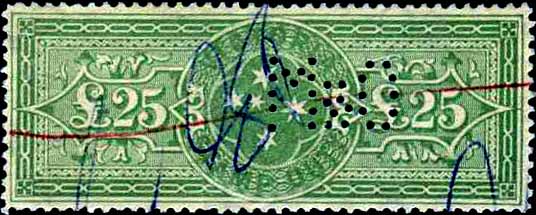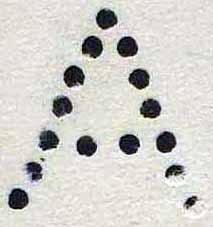JUDGING PRIVATE PERFINS ON AUSTRALIAN STATES REVENUE AND RAILWAY STAMPS AT FIP WORLD EXHIBITIONS
Dave Elsmore
This is the fourteenth in the series of ‘Let’s Educate the Judges’ in evaluating the exhibits of the Australian States Revenue and Railway Stamps.
This paper is not a critique: it is written to help guide the judge and exhibitor in this fairly new field of Perfin Exhibiting. There was some erratic judging at the Perfin Challenge in Tasmania in 2007, one exhibit was even moved away from the perfin challenge and put into another class [when every page was full of perfins] with no explanation so it is clear this needs to be addressed. I offer my 40 years of knowledge in collecting revenue and railway stamps and the Perfins found on them.

O&M reversed Ord & Minnett. Share & Stock Brokers
When judging a perfin exhibit there are several references available to the judge, 'Commercial Perfins of Australia' by Grant & Mathews 1992. The revamp to this work is ‘Australian Private Perfins’ by Mathews 2003 which is in bad need of an update. Specific web sites for Australian Perfins 'Perfin Stamps of Australia' www.perfins.com.au this web site has an exhibits tab and if you are about to judge a perfin exhibit or want to put a perfin exhibit together, I recommend you view all of these exhibits on display first. There is also quite a bit of philatelic information on Revenues and Railway Stamps at 'Revenue & Railway Stamps of Australia' www.ozrevenues.com . There is also the much publicised 'Private Revenue Perfins of Australia' 2011 by Elsmore & Coath. This up to date work can be accessed via the www.perfins.com.au web site and a must have for Judges and Exhibitors alike as it can be accessed on your mobile phone, iPad etc. So there is no excuse for getting it wrong. A judge can be standing at the frames maybe not sure of some information he is reading in an exhibit when he can quickly check this info instantaneously wherever he is in the world.

'AMPS' Australian Mutual Provident Society - Insurance
History
In 1868 one Joseph Sloper, having patented several devices for punching out railway tickets to cancel them, turned his attention to precancelling postage stamps with companies initials. On the 13th of March 1868, after much persuasion, the Postmaster-General of Great Britain finally stated that he would “...not object to the perforation of postage stamps ...” with a view to protect merchants and others, as far as possible, from the theft of stamps used by them. The Post Office had been slow in accepting Joseph Slopers invention.
The term perfin [Perforated initials] was coined by a New York collector in 1943 a Mr. H. Card. In the UK about the same era SPIFS [Stamps Perforated by Initials of Firms and Societies] was used. The accepted definition of a perfin in Australia is a stamp which has initials or any figure or design perforated into it by a business, society or other organization.
 nd so the perfin was
born, and was quickly adopted by companies both large and small. Not all perfins
were company initials. Some firms used their full name, although this was
against the Post Office's wishes, as they saw it as a form of advertising. This
form of precancelling stamps was to be without doubt the most successful
security endorsement and is still in use today.
nd so the perfin was
born, and was quickly adopted by companies both large and small. Not all perfins
were company initials. Some firms used their full name, although this was
against the Post Office's wishes, as they saw it as a form of advertising. This
form of precancelling stamps was to be without doubt the most successful
security endorsement and is still in use today.
The earliest known approval by an Australian firm to use its firm’s precancelled perforated initials was granted on 27 September 1877 by the postal department in Adelaide, South Australia, to the wholesale grocers firm of D. & J. Fowler Ltd. A two-die perforator was manufactured for D. & J. Fowler Ltd. by Joseph Sloper in early 1880. A sample strike [Sloper number 5457] is to be found in the Sloper Workshop Impression Book.
What to Exhibit

'P.R.T.' Pentland, Roberts & Thompson - Solicitors
Most perfin collections evolve over a long period of time. Rarely do large perfin collections come onto the open market as our piers would frown upon them and discard most if not all perfins found to the bin. So remainders today can be keenly chased at open auction. I can only speak for myself as to where the acquisition of perfins over 40 years of collecting came from. I have brought all that has come my way but when comparing with other perfin collectors my valued 3 copies of one firm turns into 30 sitting in another collection. By working together and sharing information we can now get an 80% idea of what is sitting in collections both here and around the world. Of course one can't speak for closet collectors or those that will just not share information.
Perfins, if presented from A to Z will do poorly on treatment, yet many perfin exhibitors, esp. newcomers, tend to present their material in this way. On the other side, if the exhibitor writes up the exhibit as a social history monograph, the judges are unlikely to read all of it. To achieve the best marks, you have to weave the perfins into a story of sorts.
Judges are liable to rate perfin exhibits very low in importance unless the exhibitor does a good job of explaining the commercial security/marketing reasons that they were introduced, and why they solved an important business problem. Because some exhibitors do not furnish the judges with a synopsis of the exhibit to lobby the importance and the relative rarity of items, judges might not have a clue. After all, as mentioned above perfins were considered 'damaged goods' for a long time.
When choosing a perfin subject some single companies could fill a single frame quite neatly other companies can fill half a page. It is survival that is the key issue here. Just because one revenue perfin may be punched into a very common 1d from Queensland with a ‘AMPS’, the very next 1d revenue from Queensland may have the punched pattern ‘L. & L. & G. INSURANCE Co’ [Liverpool & London & Globe Insurance Co. Ltd] 2 copies only have been recorded from Queensland. If 5 frames are tackled then it would be possible to choose a single Australian State to display your goodies. 8 frames of mixed states revenue & railways would give a nice balance of the whole of Australia.
Knowledge and research has to be demonstrated on each page of the exhibit. judges will be looking for philatelic knowledge rather than social knowledge mainly because perfin exhibits seem to be classed as traditional rather than social or open. Again, a synopsis can go a long way to sell the effort to research and study this area.
Condition and rarity are also difficult, because there is a bias toward what is comfortable, knowable and marketable. Few judges will give perfins a lot of rarity points, in spite of the numbers extant or the difficulty in finding them. In spite of efforts to the contrary, judges are still swayed somewhat by the cost of an item or its pedigree.
Presentation is only 5 points, and the scores generally do not fall below 3, so the worst case is you lose 2 points not a great problem certainly not worth worrying about when 95 points are spread amongst the other three criteria.
If you are exhibiting one frame only, these have another mountain to climb if the subject is so narrow that it can be covered adequately in exactly 15 or 16 pages, then, it probably is not very important.
You could split your revenue & railway exhibit into three areas: Revenue Stamps, Fiscal Postals & Railway Stamps.
Last but not least, perfins are a commercial security device to stop pilfering which were precancelled prior to use. To complete the story an exhibitor may choose show a provisional perfin in the form of a commercial security overprint [handstamped or preprinted] or show a commercial security overprint [handstamped or preprinted] that superseded a perfin pattern to complete a story.

Example of a Postal Fiscal 'N.Z./I.C.' Perfin for the New Zealand Insurance Company.
Check List:
1. Philatelic knowledge & personal research.
2. Clear images of patterns.
3. Information about users.
4. Usage period.
5. Documents.
6. New pattern finds.

'L' Lowood Creamery Brisbane
I would strongly recommend to all revenue judges to reread the FIP GREX and SREV’s before attempting to evaluate a perfin exhibit and adhere to them. Exhibitors tend to increase the size of their exhibit over a period of time as material is sourced and added to frame by frame. If an exhibit has been rewritten, do not evaluate the exhibit on past showings. Evaluate the exhibit on what you see in the frames before you.
Revenue & Railway Perfin as a new exhibiting field lacks published information and simple sources for obtaining material. Thus original research and the problem of acquisition of unusual material is more difficult than in more traditional classes. This should be appreciated by the judges.
Write critiques to help the exhibitor further his exhibit. Straight negative critiques are unhelpful at the best of time, but even worse for a new field such as revenue & railway perfins.
Treatment is left to the judge’s expertise with the exhibitor following the FIP SREV’s which can be found at the FIP web site here: https://www.f-i-p.ch/ The writer can be contacted at this email address: Dave
© copyright 1997 on
All Graphics. Dave Elsmore
No part of this page may be copied used, saved in electronic form or hard printed.